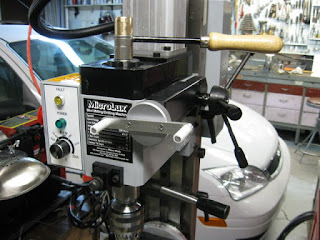As with a machine of almost any kind it needed tooling and accessories to make it useful.
I started by making a combo wrench-hammer for the draw bolt, and putting a crank handle on the micro down feed knob.
Then I acquired a holder and set of ER collets. Also made some "T" nuts, and hold down clamps, and a couple special wrenches.
The setup coincided with the starting of an Atkinson Cycle model Gas engine and a number of the machining operations were preformed on the mini mill. Shown here it is shaping the saddles for the cylinder using a fly cutter. The metal is aluminum, but it walked right through it with beautiful smooth cuts.

And here it is slotting a screw head with a tiny fly cutter.
It is fun to use this little mill, and also the lathe, Like using toys that really work. I'm impressed. Within their capacity they both do a fine job. It is also nice to have a second machine available if one of my larger machines is set up for some special operation. I find that I use them much more than I anticipated I would.









































